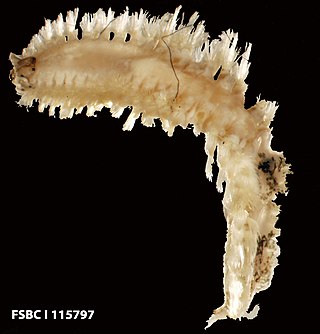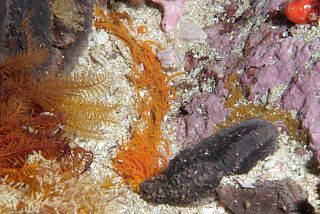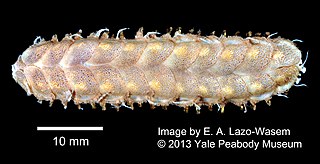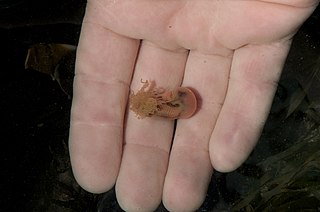
The genus Glycera is a group of polychaetes commonly known as bloodworms. They are typically found on the bottom of shallow marine waters, and some species can grow up to 35 cm (14 in) in length.

Nereis is a genus of polychaete worms in the family Nereididae. It comprises many species, most of which are marine. Nereis possess setae and parapodia for locomotion and gas exchange. They may have two types of setae, which are found on the parapodia. Acicular setae provide support. Locomotor setae are for crawling, and are the bristles that are visible on the exterior of the Polychaeta. They are cylindrical in shape, found not only in sandy areas, and they are adapted to burrow. They often cling to seagrass (posidonia) or other grass on rocks and sometimes gather in large groups.

The Terebellidae is a marine family of polychaete worms, of which the type taxon is Terebella, described by Carl Linnaeus in his 1767 12th edition of Systema Naturae.

The Serpulidae are a family of sessile, tube-building annelid worms in the class Polychaeta. The members of this family differ from other sabellid tube worms in that they have a specialized operculum that blocks the entrance of their tubes when they withdraw into the tubes. In addition, serpulids secrete tubes of calcium carbonate. Serpulids are the most important biomineralizers among annelids. About 300 species in the family Serpulidae are known, all but one of which live in saline waters. The earliest serpulids are known from the Permian.

Nephtys is a genus of marine catworms. Some species are halotolerant to a degree in that they can survive in estuaries and estuarine lagoons down to a salinity of 20 psu.

Harmothoe is a genus of marine Polychaete worms belonging to the family Polynoidae. Species of Harmothoe are found world-wide to depths of at least 5,000 m but are more common in shallower water.

Tivela is a genus of saltwater clams, marine bivalve molluscs in the subfamily Meretricinae of the family Veneridae, the Venus clams.

Phyllodoce is a genus of polychaete worms, which contains about 200 species. The prostomium bears eyes, two pairs of antennae and a pair of large retractile nuchal organs. The eversible proboscis is clearly divided into two parts.
Lysidice is a genus of polychaete worms in the family Eunicidae.

Zoanthus is a genus of anthozoans in the family Zoanthidae. It is the type genus for its family and order.

Cirriformia is a genus of marine polychaete worms in the family Cirratulidae.

Lepidonotus is a genus of marine annelids in the family Polynoidae. The genus occurs globally and includes 80 species, usually found in shallow waters down to about 80 metres.

Naineris is a genus of polychaete annelids belonging to the family Orbiniidae. It was first described by Henri Marie Ducrotay de Blainville in 1828. The type species is Nais quadricuspida Fabricius, 1780, currently accepted as Naineris quadricuspida. The genus has cosmopolitan distribution.

Maldanidae is a family of more than 200 species of marine polychaetes commonly known as bamboo worms or maldanid worms. They belong to the order Capitellida, in the phylum Annelida. They are most closely related to family Arenicolidae, and together form the clade Maldanomorpha.

Thelepus is a genus of polychaetes belonging to the family Terebellidae.
Dipolydora is a genus of polychaetes belonging to the family Spionidae.

Odontosyllis is a genus of annelids belonging to the family Syllidae.

Euphrosine is a genus of polychaetes belonging to the family Euphrosinidae.

Onuphis is a genus of polychaete belonging to the family Onuphidae.
















